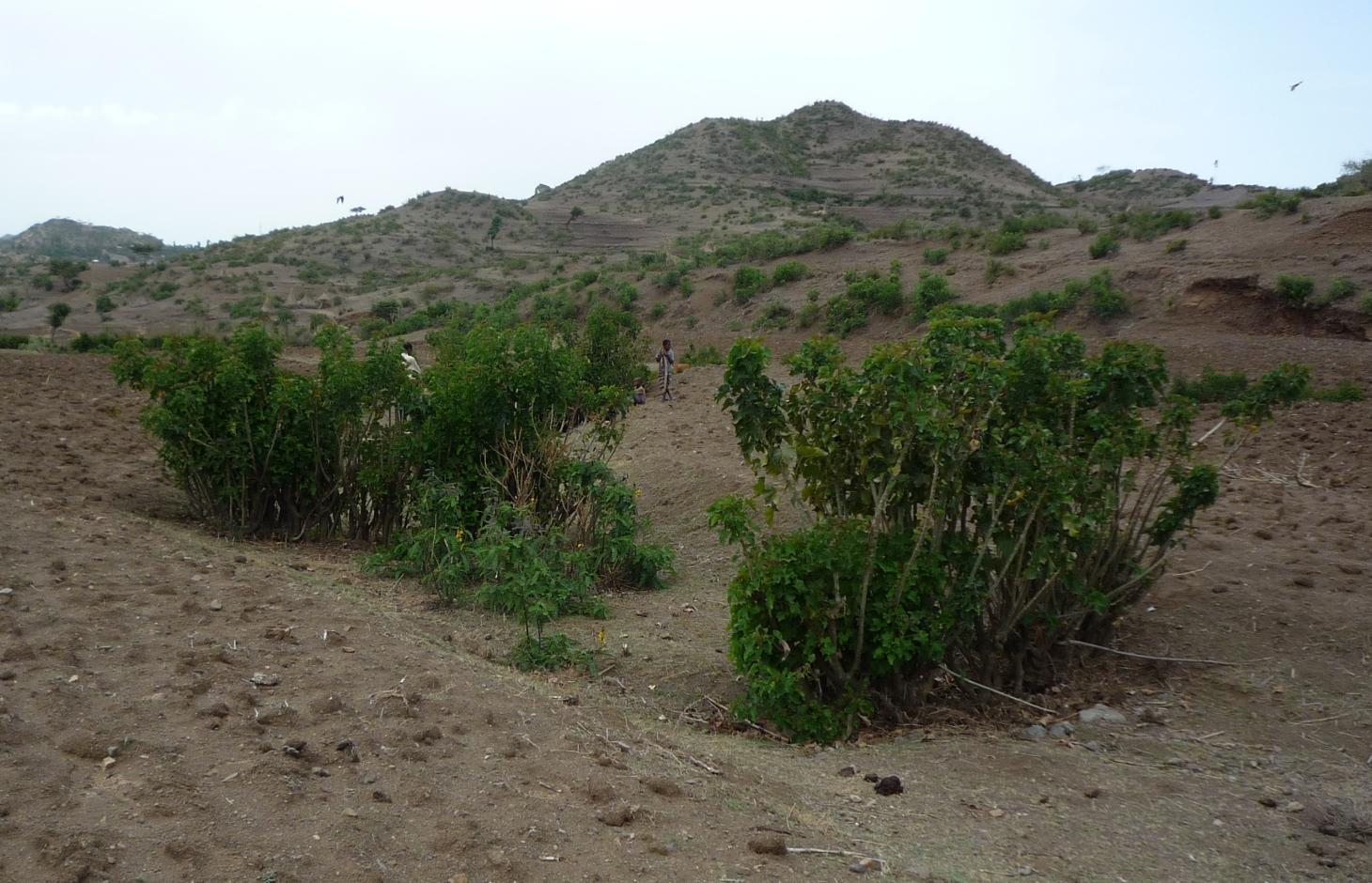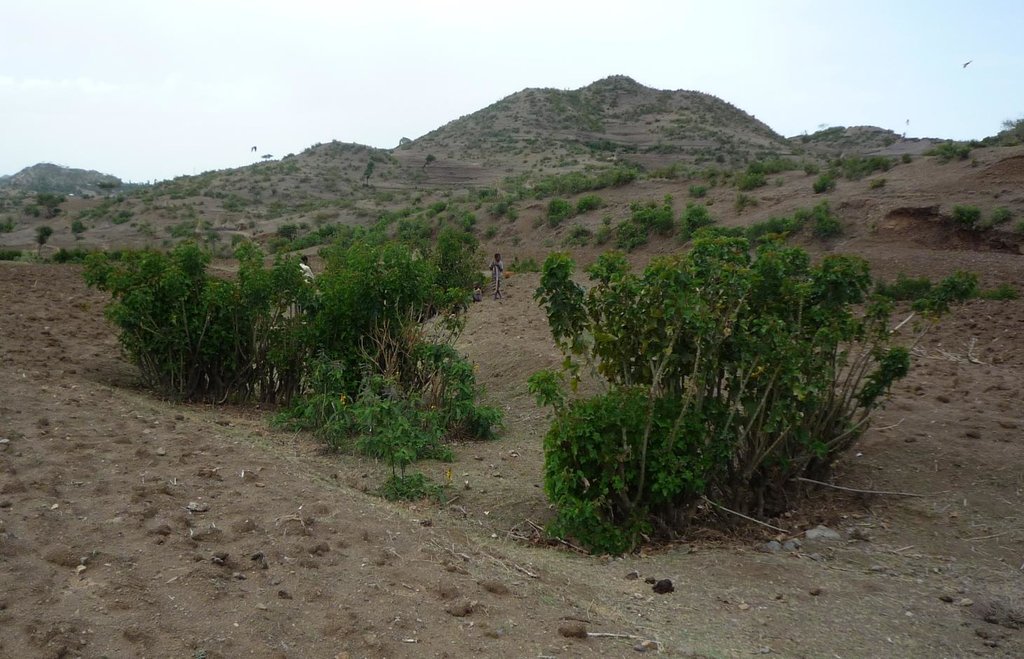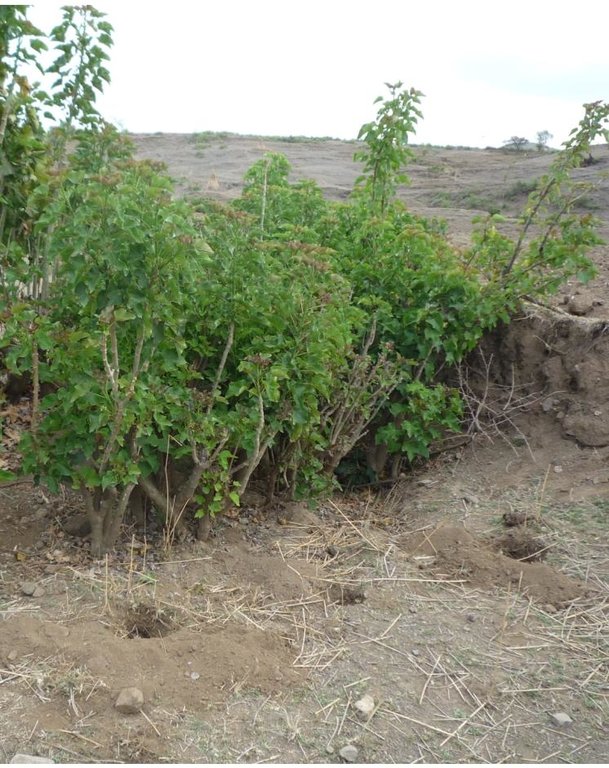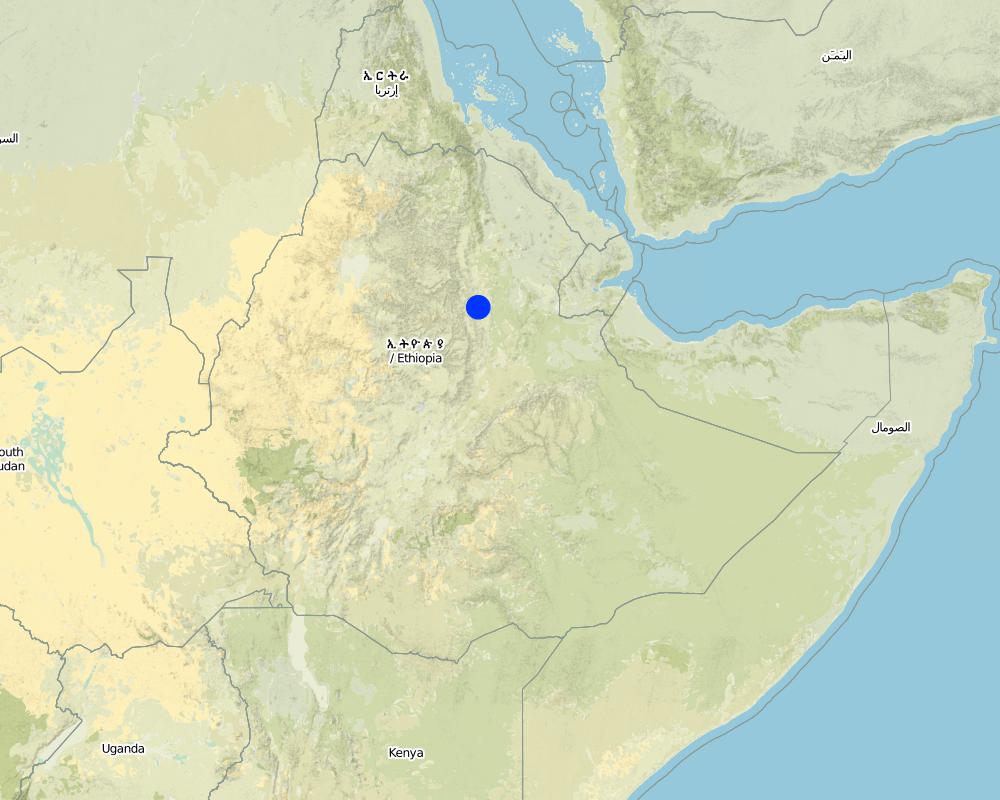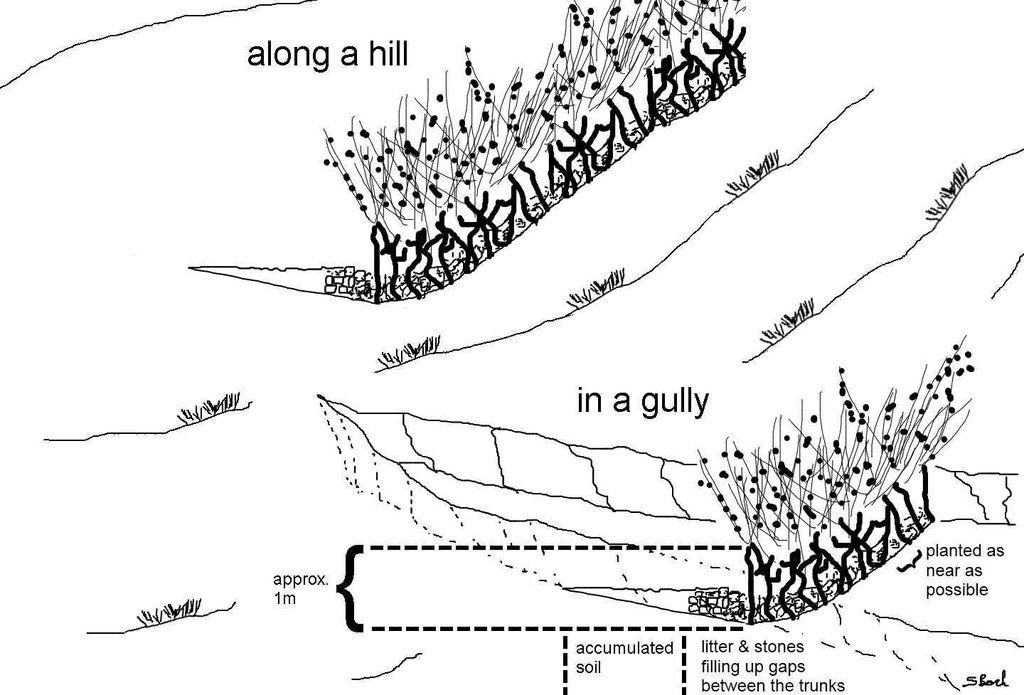Jatropha curcas hedge [Ethiopia]
- Creation:
- Update:
- Compiler: Simon Bach
- Editor: –
- Reviewers: Fabian Ottiger, Alexandra Gavilano
Agulo Keter
technologies_1524 - Ethiopia
View sections
Expand all Collapse all1. General information
1.2 Contact details of resource persons and institutions involved in the assessment and documentation of the Technology
SLM specialist:
Ayele Habtamu
Haramaya University
Ethiopia
Name of the institution(s) which facilitated the documentation/ evaluation of the Technology (if relevant)
Haramaya University (HU) - Ethiopia1.3 Conditions regarding the use of data documented through WOCAT
The compiler and key resource person(s) accept the conditions regarding the use of data documented through WOCAT:
Yes
2. Description of the SLM Technology
2.1 Short description of the Technology
Definition of the Technology:
Gully rehabilitation and hill stabilization with Jatropha hedges.
2.2 Detailed description of the Technology
Description:
In the area around Bati in Ethiopia, Jatropha is used to stabilize hills ore to rehabilitate gullies. The technology was introduced during the last decade by local farmers on their plots. The advantage of Jatropha against other shrubs is that it is poisonous and therefore not browsed by animals. Additionally the seeds can be collected by household members and sold on the local market. The seed's oil can be used as a lamp oil or even for the production of bio-fuel.
Purpose of the Technology: Besides hedges and living fences, Jatropha is used for combating sheet or gully erosion. To stop erosion processes the Jatropha cuttings are planted across a gully or along hill sides to stabilize them in the same manner as check dams or terraces do. The plant is chosen because of its very tolerant character, rather high accessibility in the area and because it is easy to propagate by cuttings. Often Jatropha is used in combination with traditional stone check dams or terraces aiming for an increased stability of the technology itself. For that purpose Jatropha is planted in front of the stone walls or also on top of them.
Establishment / maintenance activities and inputs: In earlier times Jatropha was planted by seeds but nowadays, since there are a lot of plants in the area, propagation by cuttings is the more prominent form. Since the plants are pruned every year anyway, the cuttings are accessible almost in any case for free. At markets further away, the cuttings cost around one cent per piece. In order to rehabilitate a gully Jatropha cuttings are planted as near as possible in the selected area in a row across the gully. After rooting, the spaces between the plants are filled up with litter, shrubs or stones. In order to have a thick stem and avoid competition with crops, the plants are pruned every year. The thick main stems reach a height of approximately one meter which delineates the maximum height of possible soil collection. If the area behind the filled up gaps and the cuttings has silted up, the height is increased by adding new litter in the higher up gaps. In off farming season, the Jatropha seeds are collected and sold on the market to create additional income.
Natural / human environment: The case study site, Bati, lays in an semiarid climatic zone on 1600 m a.s.l. Rainfalls are erratic and the rain sum per year is between 500-1000 mm. The landscape is very hilly with rather steep slopes. The area has a high population density and growth. The agricultural sector is very dominant and lead by a lot of small scale farming with a lot of livestock and small plots of cropland.
2.3 Photos of the Technology
2.5 Country/ region/ locations where the Technology has been applied and which are covered by this assessment
Country:
Ethiopia
Region/ State/ Province:
Ethiopia / Amhara Region
Further specification of location:
Bati
Comments:
Total area covered by the SLM Technology is 0.7 km2.
Size of the case study watershed.
Map
×2.6 Date of implementation
If precise year is not known, indicate approximate date:
- 10-50 years ago
2.7 Introduction of the Technology
Specify how the Technology was introduced:
- through land users' innovation
Comments (type of project, etc.):
Farmers are using Jatropha curcas since approximately 30 years in the research area in Bati mostly for fencing. Innovative farmers started using the plant for stabilizing existing physical structures (stone walls, terraces, gully check dams) or using it as a complete substitute for these physical structures.
3. Classification of the SLM Technology
3.1 Main purpose(s) of the Technology
- reduce, prevent, restore land degradation
- create beneficial economic impact
3.2 Current land use type(s) where the Technology is applied
Land use mixed within the same land unit:
Yes
Specify mixed land use (crops/ grazing/ trees):
- Silvo-pastoralism

Cropland
- Annual cropping
- Tree and shrub cropping
Annual cropping - Specify crops:
- cereals - sorghum
- corn
- jatropha curcas
Number of growing seasons per year:
- 1
Specify:
Longest growing period in days: 90 Longest growing period from month to month: June until September

Grazing land
Animal type:
- camels
- cattle - dairy
- goats
- poultry
- sheep
Comments:
Livestock density (if relevant):
> 100 LU /km2
Major land use problems (compiler’s opinion): Deforestation, overgrazing, cultivation of erosion-sensitive areas or steep slopes.
Major land use problems (land users’ perception): Too much soil loss and land degradation, no vegetation cover and poor soil moisture.
Grazingland comments: Livestock is not fenced in. Children herd the animals and watch out that they do not browse through crop fields. In off-farming season crop residues are collected from the field and stored next to the field. Animals are allowed to eat the still remaining residues on the field. After that, the animals are fed by the collected crop residues.
Livestock is grazing on crop residues
3.4 Water supply
Water supply for the land on which the Technology is applied:
- rainfed
Comments:
Water supply: Also mixed rainfed - irrigated
3.5 SLM group to which the Technology belongs
- cross-slope measure
3.6 SLM measures comprising the Technology

vegetative measures
- V1: Tree and shrub cover

structural measures
- S1: Terraces
- S6: Walls, barriers, palisades, fences
Comments:
Main measures: vegetative measures, structural measures
Type of vegetative measures: aligned: -contour
3.7 Main types of land degradation addressed by the Technology

soil erosion by water
- Wt: loss of topsoil/ surface erosion
- Wg: gully erosion/ gullying
Comments:
Main type of degradation addressed: Wg: gully erosion / gullying
Secondary types of degradation addressed: Wt: loss of topsoil / surface erosion
Main causes of degradation: deforestation / removal of natural vegetation (incl. forest fires) (Deforestation for the past 30 years.), over-exploitation of vegetation for domestic use (Wood collection for cooking and construction.), overgrazing (60% of the watershed area are cultivated - big grazing pressure on remaining land), other human induced causes (specify) (Cultivation of very steep slopes.), change of seasonal rainfall (Erratic rainfall.), Heavy / extreme rainfall (intensity/amounts) (If there is rain, it is intensive.), population pressure (High population pressure.), poverty / wealth (Poor facilities.)
Secondary causes of degradation: soil management (Poor soil management practices and lack of awareness.), crop management (annual, perennial, tree/shrub) (Annual cropping.), droughts (The research area is considered rather dry.), land tenure (If the land is rented, it is poorly managed.), inputs and infrastructure: (roads, markets, distribution of water points, other, …) (Poor access to fertilizer. Bad infrastructures.), education, access to knowledge and support services (Lack of awareness for soil degradation.), Low productivity of the land (As a consequence seeking for new/larger areas to increase production.)
3.8 Prevention, reduction, or restoration of land degradation
Specify the goal of the Technology with regard to land degradation:
- reduce land degradation
- restore/ rehabilitate severely degraded land
Comments:
Main goals: rehabilitation / reclamation of denuded land
Secondary goals: mitigation / reduction of land degradation
4. Technical specifications, implementation activities, inputs, and costs
4.1 Technical drawing of the Technology
Technical specifications (related to technical drawing):
Jatropha hedges as they can be found in the region of Bati. Often the plant is used for gully rehabilitation. For that purpose it is planted (mostly by cuttings) with a minimal interval between each plant to create a barrier-like hedge. The gaps are filled up with litter or stones.
Approximately 1 m of soil can be collected by the trunk - above that height it is too thin. The Jatropha seed can create additional income besides the purpose of soil and water conservation. Often, the plant is used in combination with traditional technologies (terraces, stone walls) and planted on top or in front of these traditional structures to improve their stability.
Location: South of Bati. Bati Woreda, Amhara Region, Ethiopia
Date: 05.05.2011
Technical knowledge required for land users: low (Planting takes place rather randomly in places of needs.)
Main technical functions: control of concentrated runoff: retain / trap, control of concentrated runoff: impede / retard, reduction of slope angle, increase / maintain water stored in soil, increase of groundwater level / recharge of groundwater, sediment retention / trapping, sediment harvesting
Secondary technical functions: reduction of slope length, improvement of ground cover, improvement of topsoil structure (compaction), increase in organic matter, increase in nutrient availability (supply, recycling,…), increase of infiltration, water harvesting / increase water supply, improvement of water quality, buffering / filtering water, reduction in wind speed, increase of biomass (quantity)
Aligned: -contour
Vegetative material: T : trees / shrubs
Number of plants per (ha): 10 per m
Vertical interval between rows / strips / blocks (m): ~1m
Spacing between rows / strips / blocks (m): ~20m
Vertical interval within rows / strips / blocks (m): 0.1
Width within rows / strips / blocks (m): 1.5
Vegetative measure: filling material
Vegetative material: O : other
Vegetative measure: Vegetative material: O : other
Vegetative measure: Vegetative material: O : other
Vegetative measure: Vegetative material: O : other
Trees/ shrubs species: Jatropha curcas
Other species: Stones, shrubs, sticks - things that can be found and utilized to fill up gaps between each plant.
Author:
Simon Bach, CDE, Bern, Switzerland
4.2 General information regarding the calculation of inputs and costs
other/ national currency (specify):
Ethiopian Birr
If relevant, indicate exchange rate from USD to local currency (e.g. 1 USD = 79.9 Brazilian Real): 1 USD =:
16.82
Indicate average wage cost of hired labour per day:
1.00
4.3 Establishment activities
| Activity | Timing (season) | |
|---|---|---|
| 1. | One time initial sawing of Jatropha seeds (30 years ago). | Initial. Wet season. |
| 2. | Cutting of the Jatropha cuttings (12.5 person days needed). | dry season |
| 3. | Planting of the Jatropha cuttings (12.5 person days needed). | dry season |
4.4 Costs and inputs needed for establishment
| Specify input | Unit | Quantity | Costs per Unit | Total costs per input | % of costs borne by land users | |
|---|---|---|---|---|---|---|
| Labour | Seeding | person day | 1.0 | 1.0 | 1.0 | 100.0 |
| Labour | Cutting of the Jatropha cuttings | person day | 12.5 | 1.0 | 12.5 | 100.0 |
| Labour | Planting of the Jatropha cuttings | person day | 12.5 | 1.0 | 12.5 | 100.0 |
| Equipment | Tools for cutting | 500m | 1.0 | 5.0 | 5.0 | 100.0 |
| Plant material | Seeds | kg | 1.0 | 2.0 | 2.0 | 100.0 |
| Total costs for establishment of the Technology | 33.0 | |||||
| Total costs for establishment of the Technology in USD | 1.96 | |||||
4.5 Maintenance/ recurrent activities
| Activity | Timing/ frequency | |
|---|---|---|
| 1. | Collection of Jatropha seeds (5 person days needed). | Off farming season(Okt.) |
| 2. | Filling up the gaps with litter (5 person days needed). | If necessary |
| 3. | Pruning of the Jatropha hedges (15 person days needed). | Yearly before wet season. |
4.6 Costs and inputs needed for maintenance/ recurrent activities (per year)
| Specify input | Unit | Quantity | Costs per Unit | Total costs per input | % of costs borne by land users | |
|---|---|---|---|---|---|---|
| Labour | Collection of Jatropha seeds | Person days | 5.0 | 1.0 | 5.0 | 100.0 |
| Labour | Filling up the gaps with litter | Person days | 5.0 | 1.0 | 5.0 | 100.0 |
| Labour | Pruning of the Jatropha | person days | 15.0 | 1.0 | 15.0 | 100.0 |
| Equipment | Tools | Person days | 15.0 | 0.333333333 | 5.0 | 100.0 |
| Construction material | Wood | 500m | 1.0 | 100.0 | ||
| Construction material | Stone | 500m | 1.0 | 100.0 | ||
| Total costs for maintenance of the Technology | 30.0 | |||||
| Total costs for maintenance of the Technology in USD | 1.78 | |||||
Comments:
Machinery/ tools: saw, axe
Total costs of a hectare are calculated for a hedge of 100 m length every 20 m (500 m total hedge) in the year 2011. Tool prices were estimated and labor costs were calculated with a daily wage of 1$.
4.7 Most important factors affecting the costs
Describe the most determinate factors affecting the costs:
Rough topology in the area, questionable availability of construction materials if they are not found nearby.
5. Natural and human environment
5.1 Climate
Annual rainfall
- < 250 mm
- 251-500 mm
- 501-750 mm
- 751-1,000 mm
- 1,001-1,500 mm
- 1,501-2,000 mm
- 2,001-3,000 mm
- 3,001-4,000 mm
- > 4,000 mm
Specifications/ comments on rainfall:
Erratic rainfall (rainseason from June until September)
751-1000 mm ranked 1
501-750 mm ranked 2
Agro-climatic zone
- semi-arid
Thermal climate class: tropics
LGP shorter than 90 days.
5.2 Topography
Slopes on average:
- flat (0-2%)
- gentle (3-5%)
- moderate (6-10%)
- rolling (11-15%)
- hilly (16-30%)
- steep (31-60%)
- very steep (>60%)
Landforms:
- plateau/plains
- ridges
- mountain slopes
- hill slopes
- footslopes
- valley floors
Altitudinal zone:
- 0-100 m a.s.l.
- 101-500 m a.s.l.
- 501-1,000 m a.s.l.
- 1,001-1,500 m a.s.l.
- 1,501-2,000 m a.s.l.
- 2,001-2,500 m a.s.l.
- 2,501-3,000 m a.s.l.
- 3,001-4,000 m a.s.l.
- > 4,000 m a.s.l.
Comments and further specifications on topography:
Altitudinal zone: 1501-2000 m a.s.l. (The study site is located at 1600m a.s.l.)
Landforms: Hill slopes (ranked 1) and valley floors (ranked 2)
Slopes on average: Hilly (ranked 1), rolling (ranked 2) and steep (ranked 3)
5.3 Soils
Soil depth on average:
- very shallow (0-20 cm)
- shallow (21-50 cm)
- moderately deep (51-80 cm)
- deep (81-120 cm)
- very deep (> 120 cm)
Soil texture (topsoil):
- coarse/ light (sandy)
- medium (loamy, silty)
Topsoil organic matter:
- low (<1%)
If available, attach full soil description or specify the available information, e.g. soil type, soil PH/ acidity, Cation Exchange Capacity, nitrogen, salinity etc.
Soil depth on average: Very shallow (ranked 1), shallow (ranked 2)
Soil texture: Coarse/light (ranked 1) and medium (ranked 2)
Soil fertility is low
Soil drainage/infiltration is good
Soil water storage capacity is medium
5.4 Water availability and quality
Ground water table:
5-50 m
Availability of surface water:
poor/ none
Water quality (untreated):
poor drinking water (treatment required)
Comments and further specifications on water quality and quantity:
Ground water table is unknown.
Availability of surface water: Only during rainy season
Water quality (untreated): Poor drinking water (treatment required, mostly groundwater)
5.5 Biodiversity
Species diversity:
- low
Comments and further specifications on biodiversity:
Relative to other parts of Ethiopia.
5.6 Characteristics of land users applying the Technology
Market orientation of production system:
- subsistence (self-supply)
Off-farm income:
- less than 10% of all income
Relative level of wealth:
- rich
Individuals or groups:
- individual/ household
Level of mechanization:
- manual work
- animal traction
Gender:
- men
Indicate other relevant characteristics of the land users:
Land users applying the Technology are mainly common / average land users
Population density: 100-200 persons/km2
Annual population growth: 6%
1% of the land users are rich (Adopt the most of SWC technologies).
19% of the land users are average wealthy.
89% of the land users are poor.
Off-farm income specification: Off-farm income has low importance.
Level of mechanization: Animal traction (plowing by oxen, ranked 1) and manual work (ranked 2)
Market orientation: Mixed (subsistence and commercial) Goat/sheep are main meat source (in household or on market).
5.7 Average area of land used by land users applying the Technology
- < 0.5 ha
- 0.5-1 ha
- 1-2 ha
- 2-5 ha
- 5-15 ha
- 15-50 ha
- 50-100 ha
- 100-500 ha
- 500-1,000 ha
- 1,000-10,000 ha
- > 10,000 ha
Is this considered small-, medium- or large-scale (referring to local context)?
- small-scale
5.8 Land ownership, land use rights, and water use rights
Land ownership:
- individual, titled
Water use rights:
- open access (unorganized)
5.9 Access to services and infrastructure
health:
- poor
- moderate
- good
education:
- poor
- moderate
- good
technical assistance:
- poor
- moderate
- good
employment (e.g. off-farm):
- poor
- moderate
- good
markets:
- poor
- moderate
- good
energy:
- poor
- moderate
- good
roads and transport:
- poor
- moderate
- good
drinking water and sanitation:
- poor
- moderate
- good
financial services:
- poor
- moderate
- good
6. Impacts and concluding statements
6.1 On-site impacts the Technology has shown
Socio-economic impacts
Production
crop production
Comments/ specify:
gullies are transformed to fields
risk of production failure
Comments/ specify:
improving soil moisture
product diversity
Comments/ specify:
selling the Jatropha curcas seeds
production area
Comments/ specify:
gullies are transformed to fields. Structure needs space but also gains space
land management
Comments/ specify:
gully is now flat land and traversable, structure as a new obstacle
energy generation
Comments/ specify:
Jatropha curcas seed oil as a biofuel
Water availability and quality
drinking water availability
Income and costs
expenses on agricultural inputs
Comments/ specify:
alluvial soil is relatively fertile
farm income
Comments/ specify:
new fields lead to higher productivity
diversity of income sources
Comments/ specify:
selling the Jatropha curcas seeds
economic disparities
Comments/ specify:
additional income by selling Jatropha seeds
workload
Comments/ specify:
slightly labor increase, establishment and maintenance work
Socio-cultural impacts
food security/ self-sufficiency
Comments/ specify:
additional space for new fields
community institutions
national institutions
SLM/ land degradation knowledge
Comments/ specify:
positive examples for other land users
situation of socially and economically disadvantaged groups
Comments/ specify:
up -downstream problems may be solved
Improved livelihoods and human well-being
Comments/ specify:
Accumulation of soil leads to new space for fields and additional food security or even income (if crop surplus is sold). Collection of Jatropha curcas seeds - they can be sold (additional income) or processed to oil (lamp oil etc.)
Ecological impacts
Water cycle/ runoff
water quantity
Comments/ specify:
increased soil moisture
harvesting/ collection of water
Comments/ specify:
Jatropha curcas dam blocks water flow
surface runoff
Comments/ specify:
increased infiltration, reduced flow velocity
groundwater table/ aquifer
Comments/ specify:
increased infiltration
evaporation
Comments/ specify:
maybe due to the Jatropha curcas canopy
Soil
soil moisture
Comments/ specify:
Jatropha curcas dam blocks water flow,. But additional groundwater may be logged
soil cover
Comments/ specify:
Jatropha curcas canopy
soil loss
Comments/ specify:
alluvial accumulation behind the structure
soil crusting/ sealing
Comments/ specify:
increased rooting
soil compaction
Comments/ specify:
increased rooting
nutrient cycling/ recharge
Comments/ specify:
Jatropha curcas leaves & litter
soil organic matter/ below ground C
Comments/ specify:
Jatropha curcas leaves & litter
Biodiversity: vegetation, animals
biomass/ above ground C
Comments/ specify:
Jatropha curcas biomass
plant diversity
Comments/ specify:
Jatropha curcas as a new habitat
animal diversity
Comments/ specify:
Jatropha curcas as a new habitat
beneficial species
Comments/ specify:
Jatropha curcas new habitat for worms etc
habitat diversity
Comments/ specify:
Jatropha curcas as a new habitat
pest/ disease control
Comments/ specify:
new habitat for rodents etc.
Climate and disaster risk reduction
flood impacts
Comments/ specify:
flood controll by Jatropha curcas dams
emission of carbon and greenhouse gases
Comments/ specify:
little effect by additional plants
fire risk
Comments/ specify:
Jatropha curcas wood is a bad fire wood
wind velocity
Comments/ specify:
Jatropha curcas shrub as a wind breaker
Other ecological impacts
Increased competition
Comments/ specify:
Over water and sunlight
6.2 Off-site impacts the Technology has shown
water availability
Comments/ specify:
possibility of spring development
reliable and stable stream flows in dry season
Comments/ specify:
if a spring can develop
downstream flooding
Comments/ specify:
increased infiltration/reduced flooding
downstream siltation
Comments/ specify:
trapping of the sediments by the structure
groundwater/ river pollution
Comments/ specify:
trapping of the sediments by the structure
buffering/ filtering capacity
Comments/ specify:
increased infiltration
wind transported sediments
damage on neighbours' fields
Comments/ specify:
due to gully rehabilitation
damage on public/ private infrastructure
Comments/ specify:
due to gully rehabilitation
6.3 Exposure and sensitivity of the Technology to gradual climate change and climate-related extremes/ disasters (as perceived by land users)
Gradual climate change
Gradual climate change
| Season | increase or decrease | How does the Technology cope with it? | |
|---|---|---|---|
| annual temperature | increase | well |
Climate-related extremes (disasters)
Meteorological disasters
| How does the Technology cope with it? | |
|---|---|
| local rainstorm | well |
| local windstorm | well |
Climatological disasters
| How does the Technology cope with it? | |
|---|---|
| drought | well |
Hydrological disasters
| How does the Technology cope with it? | |
|---|---|
| general (river) flood | not known |
Other climate-related consequences
Other climate-related consequences
| How does the Technology cope with it? | |
|---|---|
| reduced growing period | well |
6.4 Cost-benefit analysis
How do the benefits compare with the establishment costs (from land users’ perspective)?
Short-term returns:
slightly negative
Long-term returns:
very positive
How do the benefits compare with the maintenance/ recurrent costs (from land users' perspective)?
Short-term returns:
very positive
Long-term returns:
very positive
Comments:
Establishment needs a little time, although not very much. Maintenance work is very little needed and can be done if needed or in off-farming season. Establishment and mainentance costs are none or very little.
6.5 Adoption of the Technology
Of all those who have adopted the Technology, how many did so spontaneously, i.e. without receiving any material incentives/ payments?
- 91-100%
Comments:
Comments on acceptance with external material support: Local technology spread from farmer to farmer.
Comments on spontaneous adoption: Completely based on farmer's initiative.
There is a strong trend towards spontaneous adoption of the Technology
Comments on adoption trend: A lot of farmer are adopting (or already have adopted) Jatropha curcas as a SWC technology in the region.
6.7 Strengths/ advantages/ opportunities of the Technology
| Strengths/ advantages/ opportunities in the land user’s view |
|---|
|
Soil and water conservation are very important. Also the conservation of soil moisture. How can they be sustained / enhanced? Create farmer's awareness that SWC is very important for a sustainable land management. |
|
In combination, Jatropha curcas can also be used to stabilize traditional stone structuress (terraces, dams). These physical structures are not consideret very stable and need a lot of work to establish and maintain. How can they be sustained / enhanced? Further research to improve physical structures, Jatropha curcas structures as well as their combination. |
|
The roots bind the soil and holding it together and help collecting additional soil that otherwise would be washed out. The root and the plant also help to slow down flowing water. How can they be sustained / enhanced? Research on how tolerant is the plant on flooding etc. |
|
Jatropha curcas is also a very good life fence that animals do not browse through because the leaves are poisonous. How can they be sustained / enhanced? Create awareness in the society that the plant is poisonous and should not be eaten. |
|
The seeds can be sold. How can they be sustained / enhanced? Creating and improving markets, infrastructures and technologies that need Jatropca curcas oil or biofuel. |
| Strengths/ advantages/ opportunities in the compiler’s or other key resource person’s view |
|---|
|
Very low labor and money input for establishment and maintenance. How can they be sustained / enhanced? Keep the technology as simple as it is today. |
|
Easy to atopt in a wide range of environments (Jatroha curcas is a rather tolerant plant). How can they be sustained / enhanced? Additional research to improve knowledge of Jatropha curcas. |
|
Selling of the seeds is an additional income. If the seeds are crushed to oil it can substitute for example lamp oil that has to be bought. How can they be sustained / enhanced? Improve market situation and find technologies suitable to use Jatropha curcas oil or biofuel. |
|
The plant can be used in a wide range of rehabilitation purposes (gully rehabilitation, hill stabilization, improvment of micro climate etc.) How can they be sustained / enhanced? Create and maintain awareness of the farmers. |
|
If plantet on bare land only, the plant does not compete with food production. How can they be sustained / enhanced? Sensitize the farmers that food is more important than gaining an extra income so they do not give up their fields for Jatropha seed production. |
6.8 Weaknesses/ disadvantages/ risks of the Technology and ways of overcoming them
| Weaknesses/ disadvantages/ risks in the land user’s view | How can they be overcome? |
|---|---|
| If children eat the seeds they get sick. | Rise awareness that the plant is poisonous. |
| Plant competes for soil moisture. | Find a good compromise betweeen pruning and maximum toleratet shade as well as maximum soil moisture that can be taken by the plant to maximize yield. |
| Plant competes for sun light. | Find a good compromise betweeen pruning and maximum toleratet shade as well as maximum soil moisture that can be taken by the plant to maximize yield. |
| Weaknesses/ disadvantages/ risks in the compiler’s or other key resource person’s view | How can they be overcome? |
|---|---|
| Jatropha curcas is an alien plant although it is used for more than 30 years in the region. | Research on the long term effects of Jatropha curcas in specific areas. |
| If the plant should reach maximum yields inputs have to be increased as well and it has to be planted on fertile soil (food competition). | Make shure people only use it as fence or as a SWC plant on bare land. |
| To avoid shading the plant is often pruned every year and the yield is therefore very small (economically irrelevant). | Find a good compromise betweeen pruning and maximum toleratet shade to maximize yield. |
| The plant is poisonous. People have to take care and children have to be sensitized. But acording to the farmers eating the leaves or the seeds leads to stomach ache and is not too dangerous. | Create awareness in the society that the plant is poisonous and should not be eaten. |
| Farmers plant and use Jatropha curcas quite randomly and without any specific approach. | The role of science: find the best practice. |
7. References and links
7.1 Methods/ sources of information
7.2 References to available publications
Title, author, year, ISBN:
Bach S. (2012) Potentials and limitations of Jatropha curcas as a multipurpose crop for sustainable energy supply and soil and water conservation - a case study in Bati, Ethiopia, using the WOCAT approach. Unpublished master’s thesis, Centre for Development and Environment, University of Bern.
Links and modules
Expand all Collapse allLinks
No links
Modules
No modules


